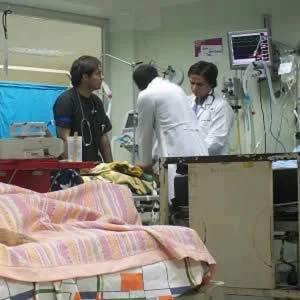The optimal ventilation rate during
cardiopulmonary resuscitation (CPR) with a tracheal tube is unknown. A new
systematic review finds that a ventilation rate recommendation of 10 min-1
during adult CPR with a secure airway (tracheal tube) and no pauses for chest
compression is a very weak recommendation based on very low quality evidence.
The study, currently available online as an accepted manuscript, will appear in
the journal Resuscitation.
The current ILCOR (International Liaison Committee on Resuscitation) ventilation recommendation of 10 min-1 was made in 2005 and stated that for a patient with an advanced airway in place, it is reasonable to ventilate the lungs at a rate of 8-10 ventilations min−1 without pausing during chest compressions to deliver ventilations. This was based on evidence from a pig study of cardiac arrest that showed that a respiratory rate of 30 min-1 as opposed to 12 min-1 was associated with increased intrathoracic pressure, decreased coronary and cerebral perfusion, and decreased ROSC (return of spontaneous circulation).
"Subsequent ILCOR recommendations in
2010 and 2015 have not identified convincing new evidence to support or refute
the 2005 recommendation. Indeed, the 2010 and 2015 recommendations are
primarily because a rate of about 10 min-1 is already in use and
there is insufficient evidence to suggest another ventilation rate. Our updated
search since the 2015 ILCOR recommendation confirms the absence of significant
new evidence," according to the review team.
For this analysis, the team performed a
systematic review up to 14 July 2016. They included both adult human and animal
studies. Based on their inclusion/exclusion criteria, one human observational
study with 67 patients and 10 animal studies (234 pigs and 30 dogs) were
included in the analysis. Regarding the animal studies, two were randomised
with a computer-generated process, one used sealed envelopes, one randomised in
blocks of four, and the others provided little or no detail of the
randomisation process.
All the 11 studies, which the team notes
"carried a high risk of bias," evaluated for ROSC outcome. All
studies showed no improvement in ROSC with a ventilation rate of 10 min-1
compared to any other rate. The evidence for longer-term outcomes such as
survival to discharge and survival with favourable neurological outcome was
very limited, says the review team.
"Ventilation rate is just one
component of ventilation, and our knowledge of other aspects of ventilation
during CPR is also extremely limited. For example, our knowledge of the optimal
tidal volume, inspired oxygen, airway pressure and interaction between chest
compression and ventilation during CPR is very limited," the authors
write. "Future studies will need to look at a combination of factors to
help us understand the role of ventilation rate during CPR."
Source: Resuscitation






